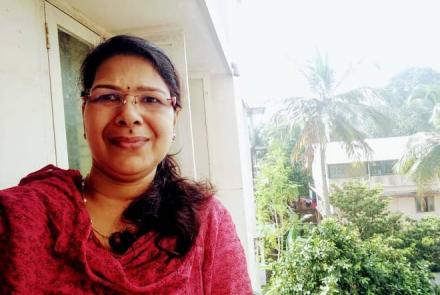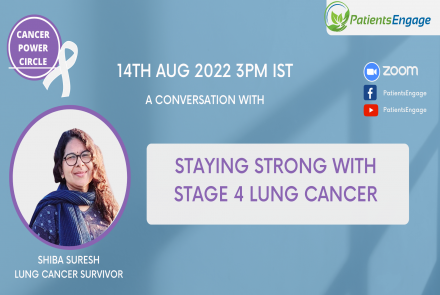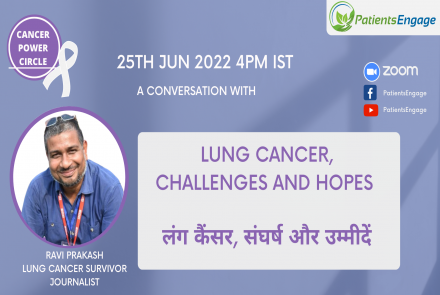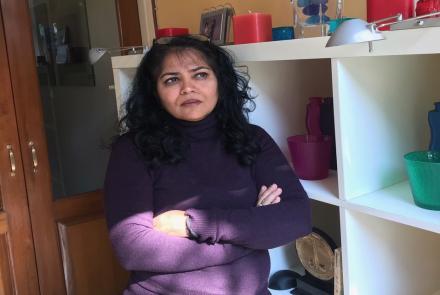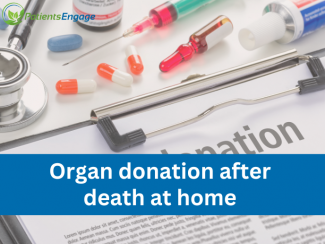
Cancer that starts in the lungs is called primary lung cancer. The lungs are common sites for metastasis of other types of cancers, which start elsewhere in the body, such as breast cancer or colon cancer. That is called secondary lung cancer. It is important to know whether the cancer started in the lungs (primary) or has spread to the lungs (secondary). Cancer cells will be different in primary and secondary lung cancer, so the treatment will depend on the type of cancer. For eg. cancer that started in the breast and has spread to the lungs will respond to breast cancer treatment.
Lung cancer is categorised as Small and Non-small.
- Small cell lung cancer (SCLC): SCLC comprises about 15% of all lung cancers. Cancer cells have a specific appearance under the microscope and are also called Oat Cell carcinoma. SCLC is the most aggressive and rapidly growing of all lung cancers. SCLC is strongly related to smoking. Only 1% of this cancer occurs in non-smokers. SCLC starts in the bronchi near the centre of the chest. SCLC metastasizes rapidly and is often diagnosed after it has spread to other parts of the body.
- Non small cell lung cancer (NSCLC): This is the most common type of lung cancer and comprises 85% of total lung cancer. NSCLC has 3 subtypes and cells in these subtypes differ in size and shape:
- Adenocarcinoma of the lung: Adenocarcinomas make up to 50% of all lung cancers. Most of the Adenocarcinomas are associated with smoking, but it is also the most common form of cancer in non-smokers. Adenocarcinoma of lung develops from the cells that line the airways and produce mucus (phlegm). This begins in the outer part of the lung. This type of cancer can be present for a long time before it is diagnosed.
- Squamous cell carcinoma: This is also known as Epidermoid carcinoma. This causes about 30% of all lung cancers. Squamous cell carcinoma is linked with a history of smoking. This cancer develops from the cells lining the airways and in the centre part of the lungs in the bronchus.
- Large cell carcinoma: This is also called undifferentiated lung cancer. These are the least common type of NSCLC and about 5% of all lung cancers. It is associated with smoking. Large cell carcinoma can appear in any part of the lung. Cancer cells looks large and rounded under microscope. Large cell carcinoma grows quite fast, which makes it difficult to treat.
Carcinoid tumours: These are the less common types of lung cancer and account for about 5% of all lung cancers. These are slow growing and generally small when diagnosed. These tumours arise from the cells which produce a hormone-like substance.
Stages of lung cancer
Cancer staging is a process to determine how far the cancer has spread. The staging of cancer helps to decide the treatment and make an informed prognosis.
Stage grouping of Non small cell lung cancer (NSCLC):
- Stage 0 (carcinoma in situ): Cancer cells are found in the top layer of cells lining the air passage. It has not invaded into nearby tissue and not spread to lymph nodes.
- Stage I : Tumour is located in the lung and has not spread to the lymph nodes.
- Stage IA: Tumour is less than 3cm and has not spread to any lymph nodes
- Stage IB:Tumour is more than 3cm but less than 5cm but has not spread to any lymph nodes or has grown in to main bronchus and at least 2cm below where trachea joins the bronchus ( carina) or tumour has grown in to the pleura (membrane that covers the lung).
- Stage II : Tumour is in the lungs and nearby lymph nodes
- Stage II A: Tumour is larger than 5cm but less than 7cm that has not spread to the nearby lymph node or has spread to the main bronchus and at least 2cm below carina or has spread to the pleura or is less than 5cm that has spread to the nearby lymph nodes.
- Stage IIB: Tumour is larger than 5cm but less than 7cm that has spread to lymph nodes or has spread to the bronchus and at least 2cm below carina or is larger than 7cm that may or may not have invaded nearby structures in the lung but has not spread to the lymph nodes.
- Stage III : Tumour is in the lungs and in the lymph nodes in the centre of the chest.
- Stage IIIA: Tumour is larger than 7cm and has spread to the lymph nodes on the same side of the chest where cancer started or has invaded the diaphragm.
- Stage IIIB: Tumour is larger than 7cm and has spread to the lymph nodes on the other side of the chest or above the collar bone.
- Stage IV: Tumour has spread to both lungs, to the fluid in the area around lungs or to other parts of the body such as liver, brain or bones.
TNM staging for Non small cell lung cancer TNM is another way to classify cancer.
T stands for tumour size.
- Tx – Primary tumour cannot be assessed
- T0 – No evidence of primary tumour
- Tis – Carcinoma in situ
- T1 – Tumour is less than 3cm surrounding by lung or visceral pleura without bronchoscopic invasion.
- T1a- Tumour is less than 2cm
- T1b – Tumour is more than 2cm but less than 3cm
- T2- Tumour is more than 3 cm but less than 7cm with any of these features; involves main bronchus, less than 2 cm distal to carina, invades visceral pleura.
- T2a- Tumour more than 3cm but less than 5cm
- T2b – Tumour more than 5cm but less than 7cm
- T3 – Tumour more than 7cm or one that directly invades either the chest wall, diaphragm, pherenic nerve, or mediastinal pleura or that the tumour in main bronchus is more than 2cm distal to carina.
- T4 – Tumour of any size, which had spread to the mediastinum, heart, great vessels, trachea, oesophagus, carina, or vertebral body.
N stands for lymph node involvement.
- Nx – Nearby lymph nodes cannot be assessed
- N0 – No lymph node spread
- N1 – Spread to same side of peribronchial, hilar lymph nodes or intrapulmonary nodes
- N2 – Spread to same side mediastinal or subcarinal lymph nodes
- N3 – Spread to opposite side mediastinal, hilar or supraclavicular lymph nodes
M stands for metastasis
- Mx – Distance metastasis cannot be assessed
- M0 – No distant metastasis
- M1 – Distant metastasis
- M1a – Tumour has spread to the other lung, fluid around the lung (pleural effusion) and fluid around the heart (pericardial effusion).
- M1b - Tumour has spread to the distant lymph nodes or to the other organs such as liver, brain or bones.
Staging for Small cell lung cancer is as follows:
- Limited stage: Limited stage refers to cancer, which is confined to its area of origin in chest.
- Extensive stage: Cancer has spread beyond the chest to other parts of the body.







